Hong Kong enters 16th weekend of protests as police warn violence escalating beyond control

Hong Kong protests continue for 15th straight week 01:40
Hong Kong (CNN)Hong Kong is headed into its sixteenth consecutive weekend of anti-government protests, as police warned the level of violence is escalating potentially beyond control, as the force faced renewed allegations of brutality.
Last week saw multiple fights between protesters, counter demonstrators and apparent bystanders on the sidelines of an unauthorized march which dissolved into pitched battles between the crowd and police, with one side throwing petrol bombs and bricks and the other firing water cannon and tear gas.
At a background briefing for foreign media Friday, a senior Hong Kong police commander said officers were concerned that the level of physical force was reaching a point where they might be forced to use live ammunition to defend themselves or others.
"Our officers are worried that the level of violence has got to such a level that they might have to kill someone or be killed themselves," the commander said. "We have been so restrained but in the face of such violence this pressure has become extremely dangerous."
On multiple occasions in previous weeks, police officers have pulled sidearms or fired their weapons in the air during confrontations with protesters, in circumstances they said were life threatening.
During the briefing, police showed reporters a several minute compilation video -- with the filename "torture" -- of acts of violence by protesters against bystanders.
"We could be here watching these video clips until the end of the month if we wanted to," the senior commander said.
Police are facing renewed accusations of brutality themselves this week, after Amnesty International released a report detailing what it said were instances of torture and abuse in custody.
"Hong Kong's security forces have engaged in a disturbing pattern of reckless and unlawful tactics against people during the protests," the human rights group said, adding that one man claimed police "beat him severely and threatened to break his hands if he tried to protect himself," while another officer "threatened to electrocute a man's genitals" if he would not unlock his phone.
More than 1,300 people have been arrested since protests began in June. The Amnesty report, which is based on interviews with 38 people, including lawyers, medical professionals and 21 arrested protesters, found that in more than 85% of cases investigated (18 out of 21), the arrested person was hospitalized.
"Time and again, police officers meted out violence prior to and during arrests, even when the individual had been restrained or detained. The use of force was therefore clearly excessive, violating international human rights law," said Nicholas Bequelin, East Asia Director at Amnesty International.
In response, police said they have always respected the rights of those in custody and said there were existing complaint mechanisms in place to report alleged abuses.
The senior police commander dismissed the Amnesty report as "not credible." They echoed the official remarks, adding that "in any prolonged situation of this nature, I would be dishonest if I tell you I believe that no one has overstepped the line."
"You are talking about a prolonged situation where there is chaos and violent encounters, but it is important to note that we have procedures to deal with any allegations of excessive use of force," the commander added. "I would note that we are covered by among the highest concentration of journalists in the world, our actions are highly transparent."

Hundreds of Hong Kong protesters sing defiant anthem03:24
When asked about the suggestion that officers may end up killing a demonstrator in self-defense, protester Bonnie Leung -- of the Civil Human Rights Front -- said police using real ammunition and guns was "unnecessary and unjustified." Leung added that officers are able to protect themselves in "many different ways."
"They already have the power of arrest, they already have the power to use force, but they are using disproportionate force already. They have the least lethal weapons... They now have rubber bullets, they now have water cannons -- they have everything," she said.
"But what they are doing is that they are not just trying to protect themselves... they are actually doing more than necessary and more than the laws allow them to do in order to anger the protesters even more, and that creates danger."
Escalating violence
Allegations of police brutality have been a key rallying cry of the months-long protests, with crowds calling for an independent investigation.
While the government has announced the withdrawal of an extradition bill with China that kickstarted the summer of discontent, it has so far refused to consider investigating police outside the official system, though Chief Executive Carrie Lam has named two new members to an existing investigative body in an attempt to alleviate public concerns.
The senior police commander said that with regard to an independent investigation, "you really have to be sure that whatever measure you take now is helpful to the resolution of the situation, that you are not playing into the hands of people whose only objective is to undermine the police so this situation could get worse."
The commander added that it could lessen the effectiveness of police on the front lines were they to face investigation during the unrest.
"We are still in the middle of a crisis," the commander said. "Every single day we are still out there facing this threat."
Some of the most violent scenes last week were not during the now familiar stand offs between protesters and police, but around the edges of the march, where both protester and pro-government groups attacked people who disagreed with them.
CNN reporters saw a mob of masked protesters attacking a man in the Tin Hau neighborhood after a brief confrontation, leaving him dazed and bleeding on the floor. In an earlier incident, video shared widely online showed a middle-aged man wearing a blue shirt attacked and left apparently unconscious by a large group of mostly young, black-clad protesters on Gloucester Road. According to the South China Morning Post, the unidentified man had shouted pro-police slogans before the attack.
Later on Sunday, a group of mostly middle-aged men were seen striking and threatening protesters in the North Point area. The area has a large mainland Chinese immigrant population, and there have been attacks on protesters in the area in past weeks.
Sunday's violence came after a number of angry scuffles on Saturday between pro and anti-government groups, though none reached the level of violence seen the following day. Pro-Beijing groups sang the Chinese national anthem and pulled down "Lennon Walls," collections of notes and flyers erected by protesters, around the city.
There were fears of further scuffles this weekend over a "Clean Hong Kong" campaign organized by stridently anti-protest lawmaker Junius Ho. Speaking to CNN earlier this week, Ho described the event on Saturday as an "environmental hygiene campaign" and said he "would not urge any confrontation" with protesters.
Police expressed concern that there would be violence during these events, and said they could potentially be declared an illegal gathering.
"In the end if there is violence we will deal with that," the senior police commander said.

Pro-government and anti-government supporters chant against one another at a shopping mall in Hong Kong on Friday, September 13. The sign translates to "Stop violence and curb chaos; safeguard Hong Kong."

Demonstrators hold up their cell phone lights as they form a human chain at the Peak, a tourist spot in Hong Kong, on September 13.
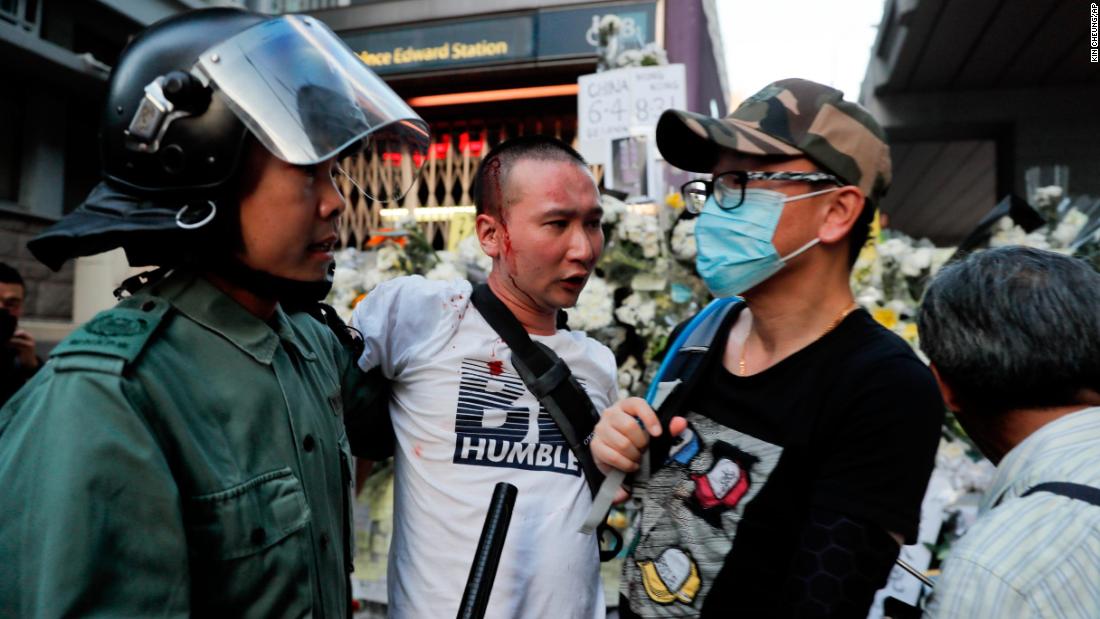
Police escort an injured man after he attacked protesters outside Prince Edward station in Hong Kong on Friday, September 6.
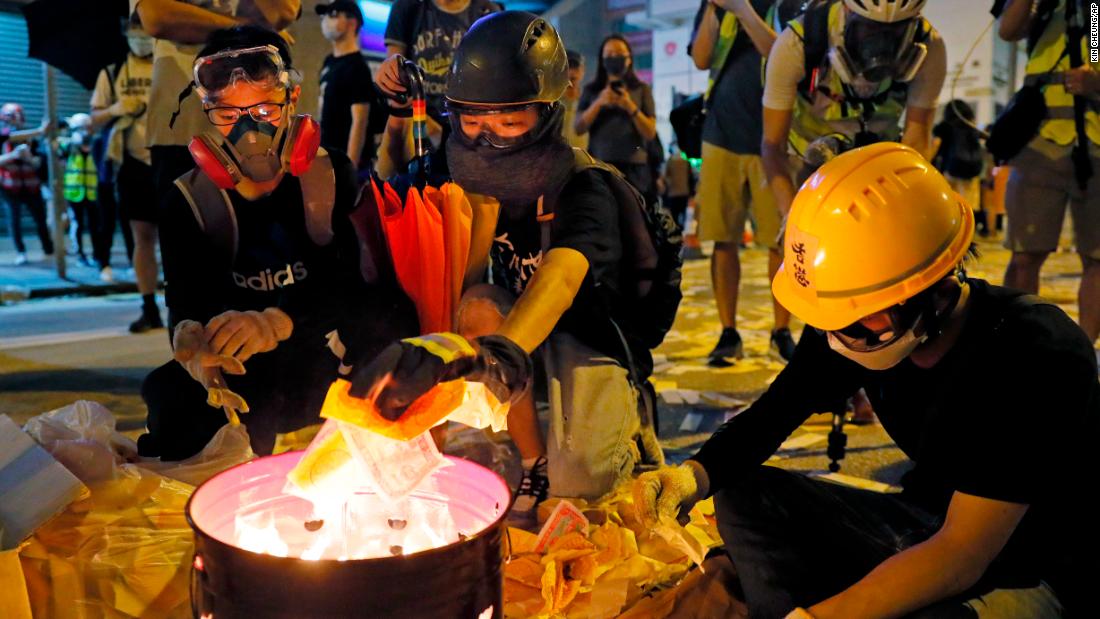
Protesters burn paper money to pay their respects to injured protesters.
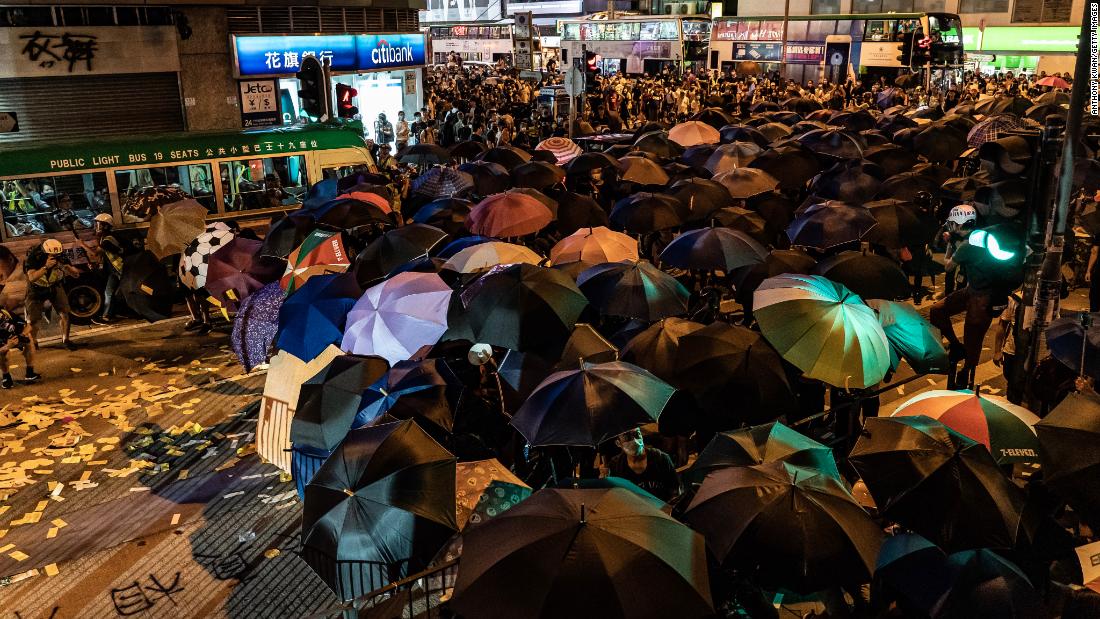
Protesters prepare to clash with police outside the Mong Kok police station on September 6.

A protester is detained by police at the Po Lam Mass Transit Railway station on Thursday, September 5.

A man watches televisions at a store in Hong Kong as Chief Executive Carrie Lam announces the withdrawal of the extradition bill on Wednesday, September 4.
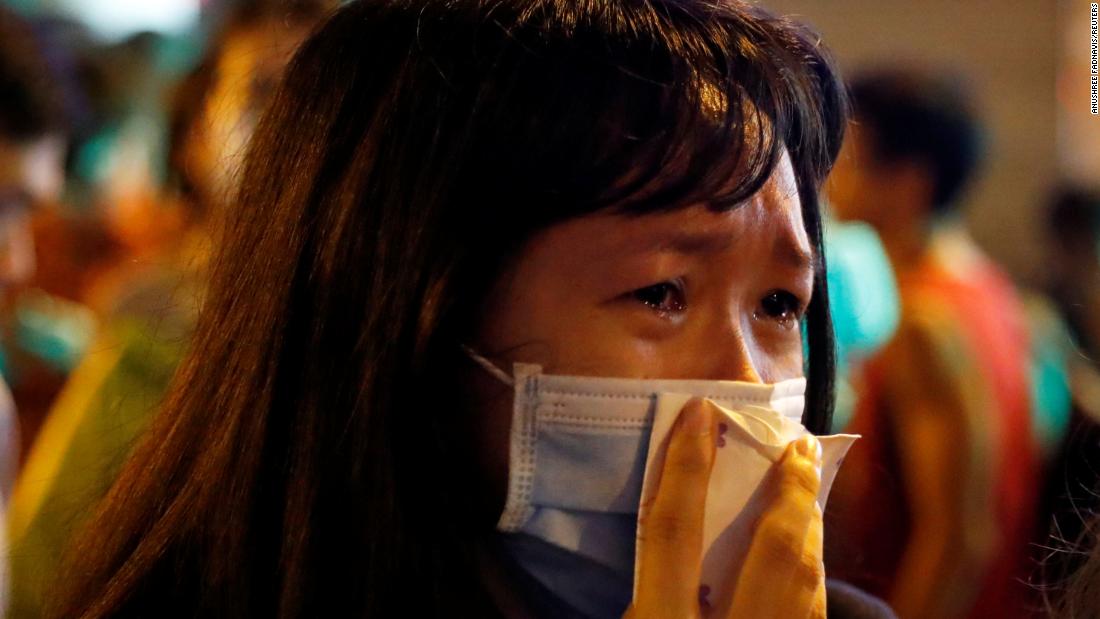
A woman gets emotional on September 4 while paying her respects to protesters who were injured a few days earlier.

Police aim at protesters outside the Mong Kok police station on September 4.

Demonstrators travel through a railway station during a rally on Tuesday, September 3.

Students wearing gas masks and helmets hold a banner that reads "five major demands are indispensable" at St. Francis' Canossian College in Hong Kong.

Protesters gather in the bus terminal at Hong Kong International Airport on Sunday, September 1. Hundreds of pro-democracy activists attempted to block transport routes to the city's airport.

A passenger walks to the airport on September 1 as pro-democracy protesters blocked a road outside the airport.

A protester uses a slingshot outside the Central Government Complex during clashes with police on Saturday, August 31. Thousands of pro-democracy protesters held an anti-government rally one day after several leading activists and lawmakers were arrested in a sweeping crackdown.

Protesters stand in front of a burning barricade as clashes with the police intensified on August 31.
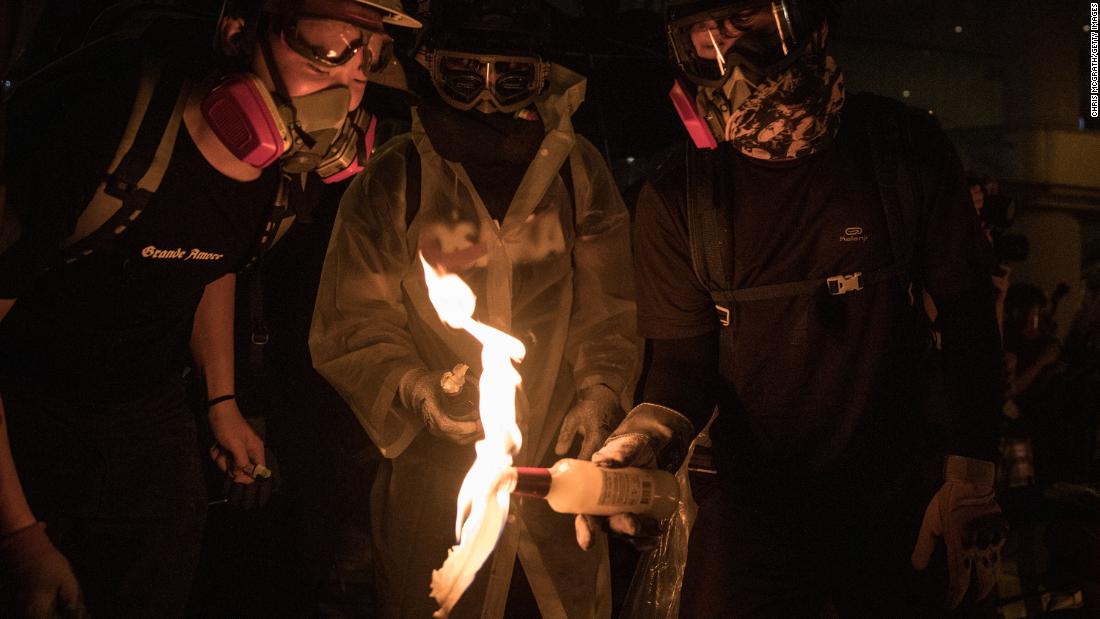
Protesters light a Molotov cocktail on August 31.

Police officers move forward during clashes with protesters on August 31.
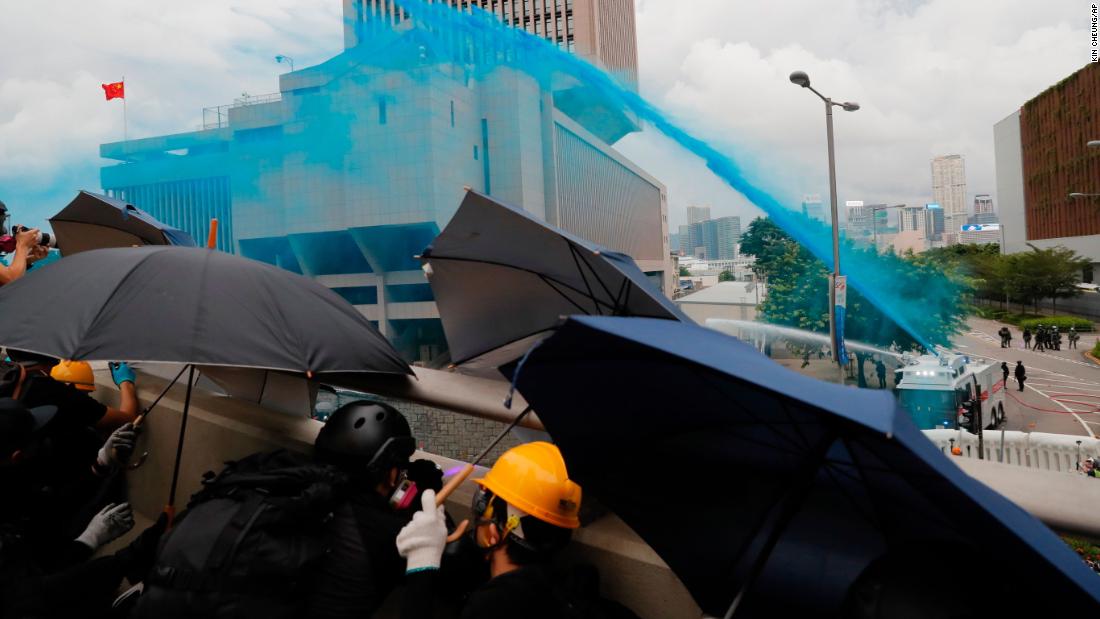
Protesters take cover as policemen fire blue-colored water on them. Blue dye can be used to stain and identify masked protesters.
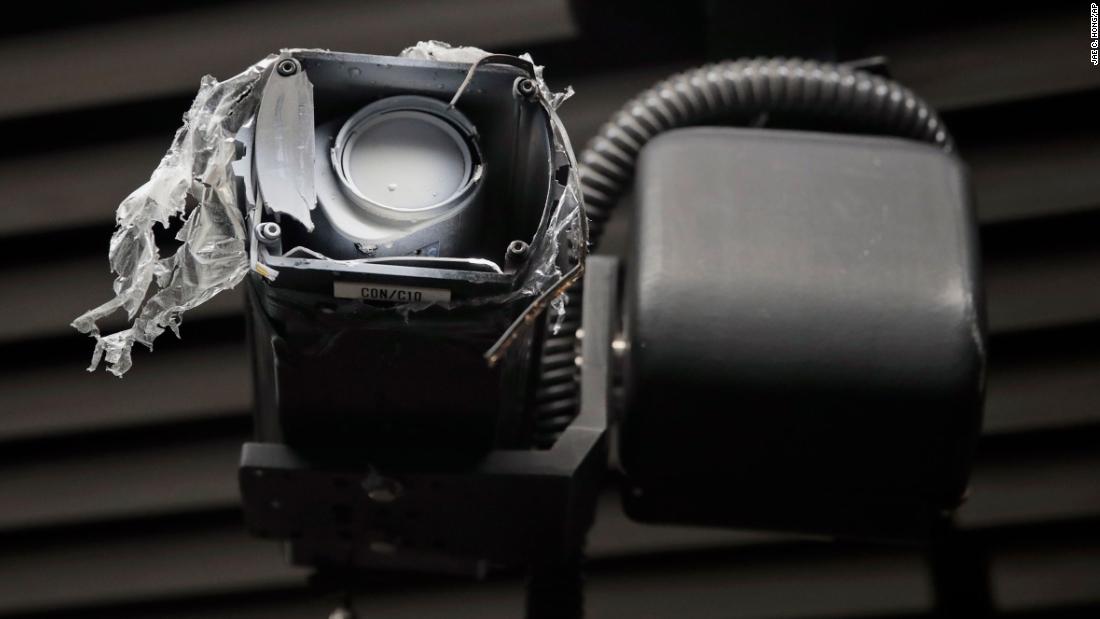
A surveillance camera is covered with white paint during protests.

An overhead view shows protesters reacting after police fired tear gas on August 31.

Pro-democracy activists Agnes Chow and Joshua Wong speak to the media after they were released on bail at the Eastern Magistrates Courts on Friday, August 30. They were arrested earlier the same day in a dragnet across Hong Kong.

Protesters clash with police after a rally in Hong Kong's Tsuen Wan district on Sunday, August 25. It was one of the most violent nights seen in Hong Kong since mass protests began in June.
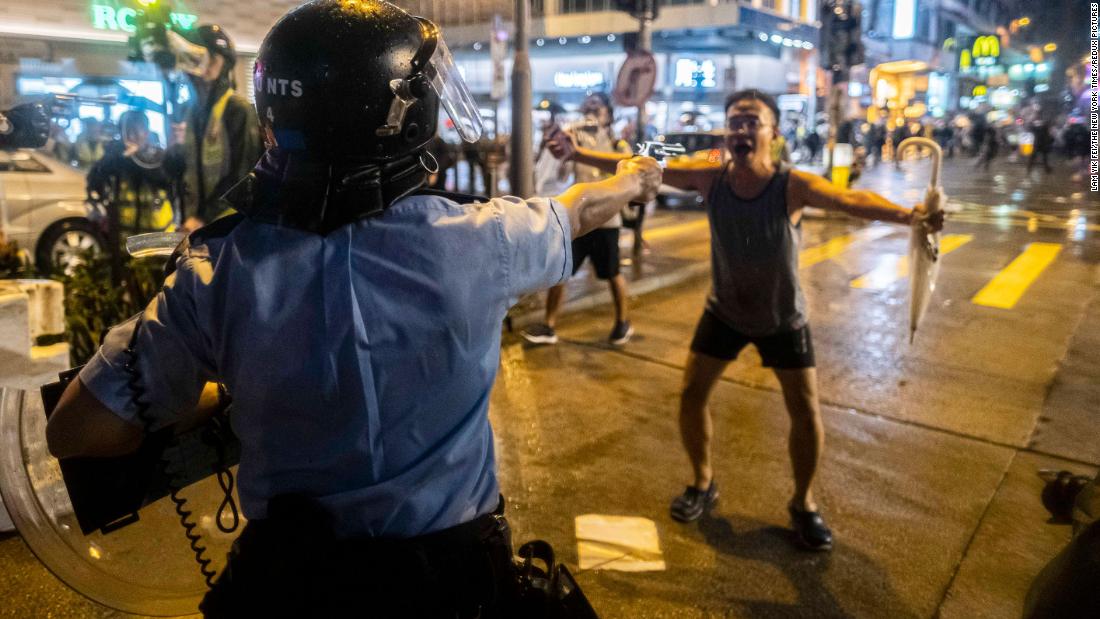
A police officer aims a gun in front of a protester on August 25.

Some protesters shine laser pointers at police lines on August 25.

Protesters and police clash on Saturday, August 24.
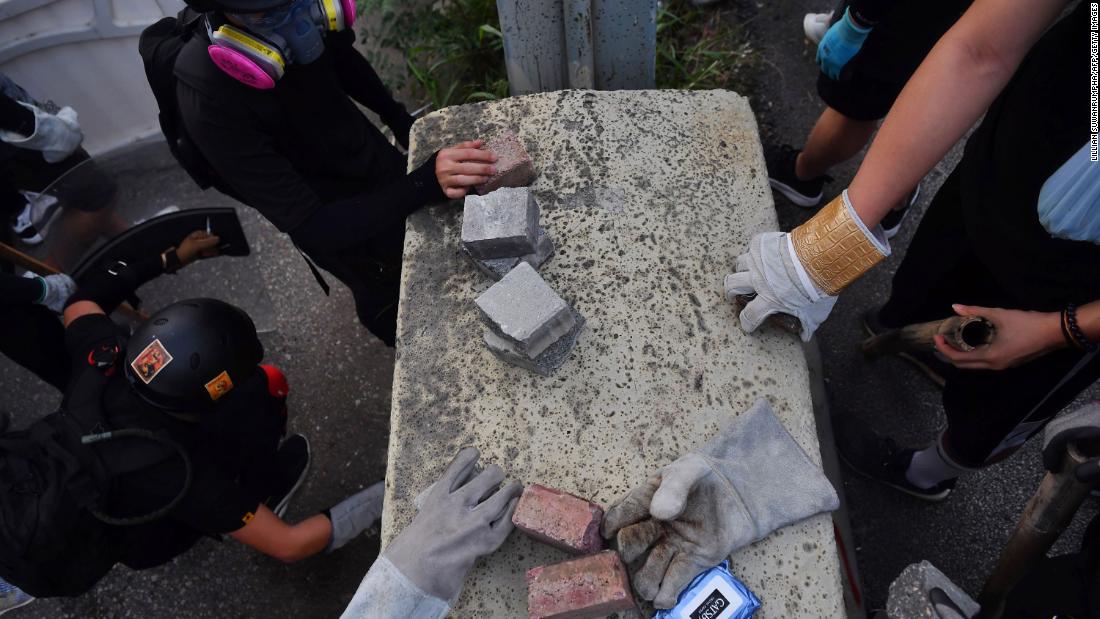
Protesters pick up bricks to be used as projectiles on August 24.
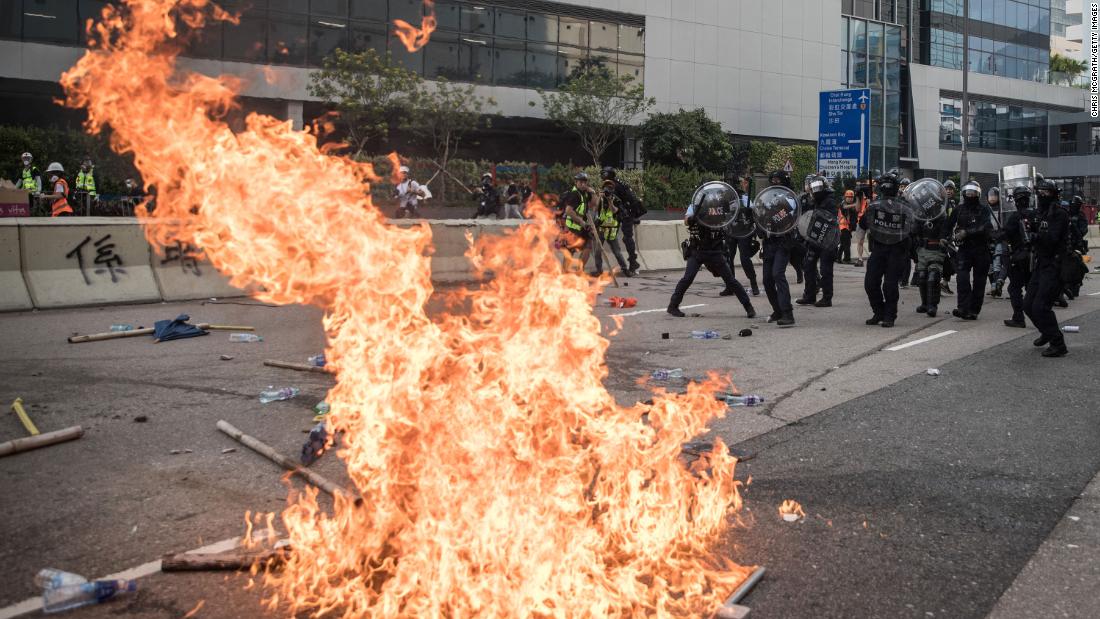
Police retreat after clashing with protesters on August 24.

People link hands as they gather at the Tsim Sha Tsui waterfront on Friday, August 23. Protesters formed a human chain across Hong Kong in a show of solidarity.

Cell phones shine from the top of Lion Rock on August 23.

Protesters march under umbrellas on Sunday, August 18.
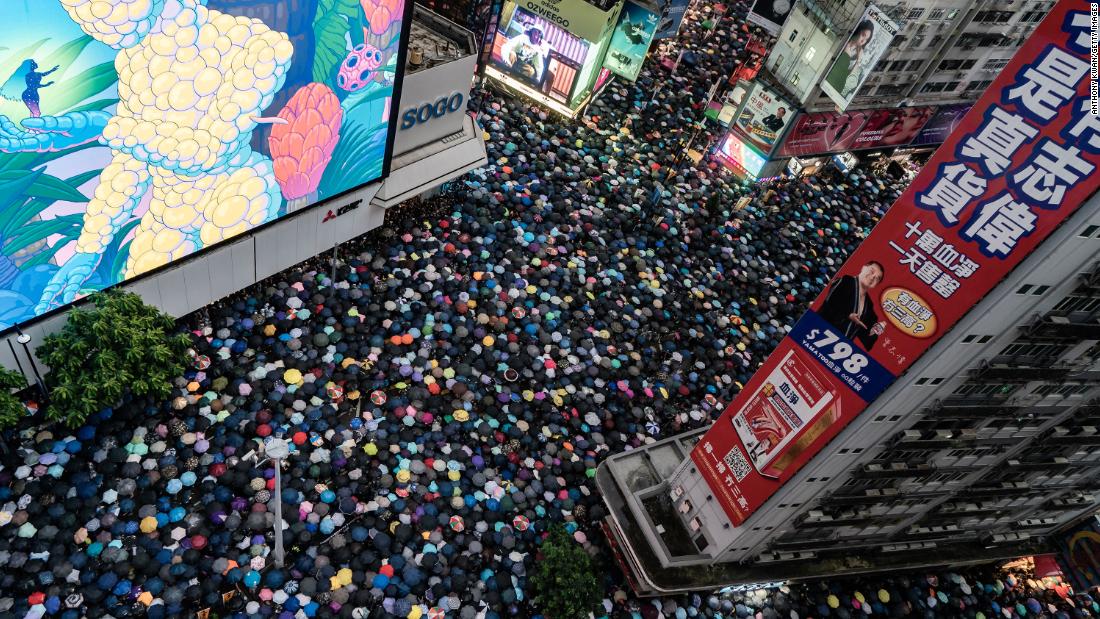
Tens of thousands of protesters showed up in the streets on August 18.
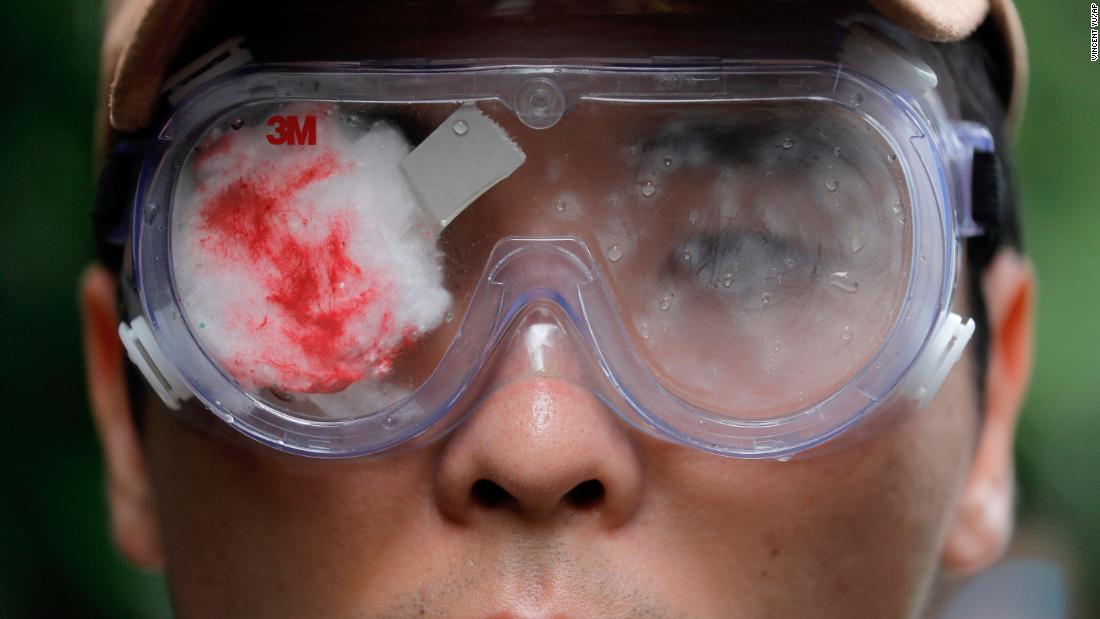
A protester participates in a march on Saturday, August 17. His eye is covered with red gauze, referencing a woman who was allegedly shot in the eye with a beanbag round during clashes between protesters and police.

A protester ties a white ribbon, symbolizing the pure intentions of young protesters, during a march organized by teachers in Hong Kong on August 17.

Protesters react after police fired tear gas to disperse a demonstration at the Sham Shui Po police station in Hong Kong on Wednesday, August 14.

Protesters point lasers at the Sham Shui Po police station on August 14.
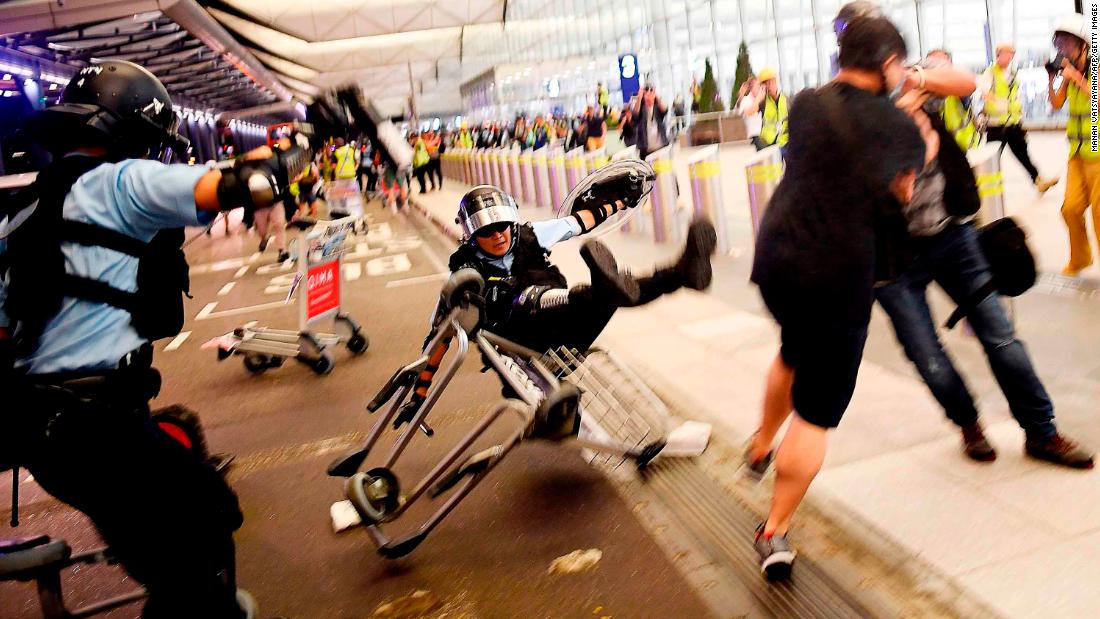
A police officer falls over an airport luggage trolley during a scuffle with pro-democracy protesters on Tuesday, August 13. For two days, protesters flooded the airport. Check-ins were suspended and dozens of outgoing flights were canceled.

Police use pepper spray to disperse protesters at the airport on August 13.

Police and protesters clash at the airport on August 13. The violence came after Hong Kong's Airport Authority announced that all check-in services would be suspended for another night because of terminal operations being "seriously disrupted."

A traveler passes her luggage to security guards as she tries to enter the departures gate.
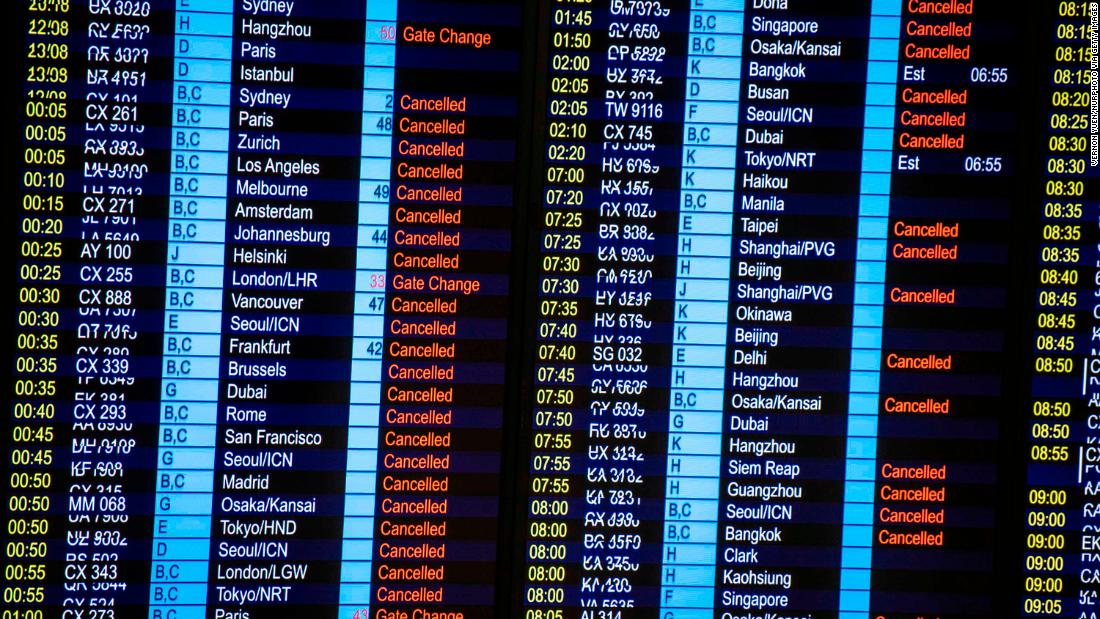
A display board shows canceled flights on August 13.

Anti-government protesters stand at a barricade made of luggage trolleys during a demonstration at the airport on August 13.

Medics look after a woman who received a facial injury during clashes on Sunday, August 11.
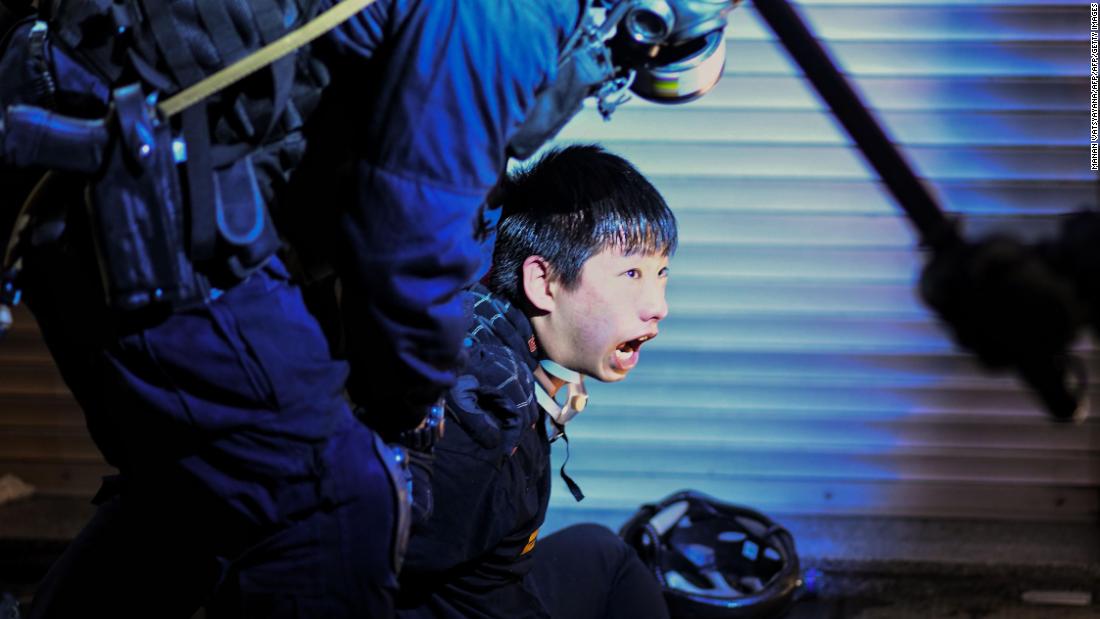
A pro-democracy protester is held by police outside the Tsim Sha Tsui police station on August 11.

Police fire tear gas at protesters during a demonstration in the Wong Tai Sin District on Monday, August 5.

A train passenger gestures toward a protester, right, who was preventing the doors of a train from closing on August 5. The protester was trying to disrupt Hong Kong's morning rush-hour commute.

A man lies down on an underground train during a protest on August 5.
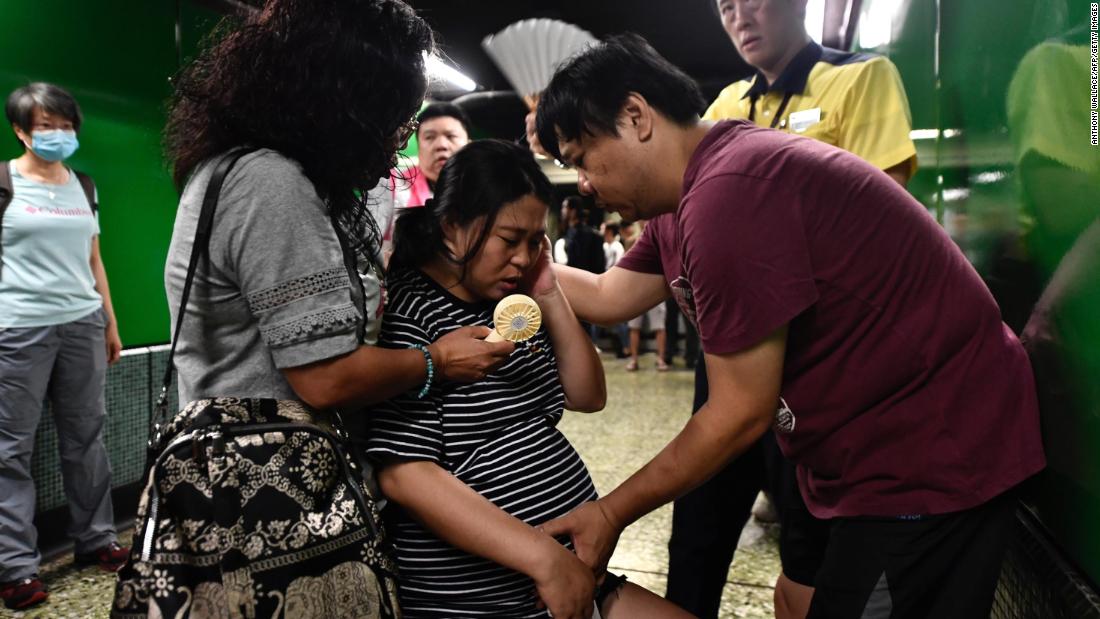
A man comforts his pregnant wife near a train platform after protesters blocked the train doors on August 5.

A protester stands in tear gas during a confrontation with police in the early hours of Sunday, August 4.

A Chinese flag floats in water after it was thrown by protesters during a demonstration on Saturday, August 3.

A protester sprays paint on a wall on August 3.
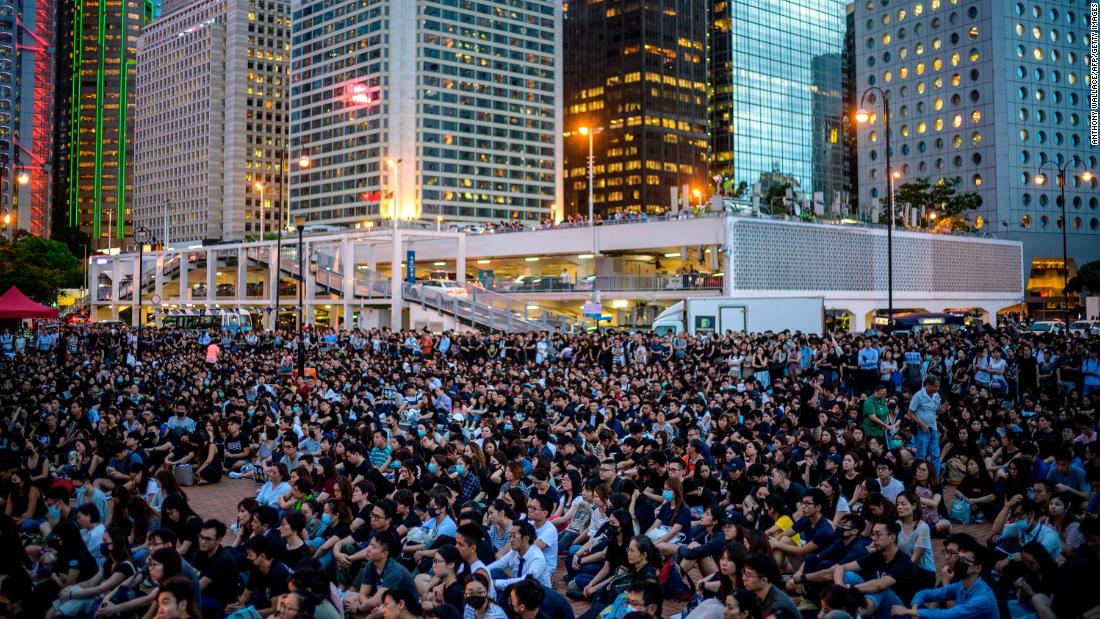
Members of Hong Kong's medical sector attend a protest in Edinburgh Place on Friday, August 2.

The emblem on the China Liaison Office is protected by plexiglass during a demonstration on Sunday, July 28.

A protester flees from baton-wielding police in the Yuen Long district of Hong Kong on Saturday, July 27.

A protester looks through umbrellas during the clashes with police on July 27.

Travelers watch as protesters rally at Hong Kong's international airport on Friday, July 26.

Protesters clash with police on Sunday, July 21.

Masked men in white T-shirts are seen after attacking anti-extradition bill demonstrators at a train station in Yuen Long.
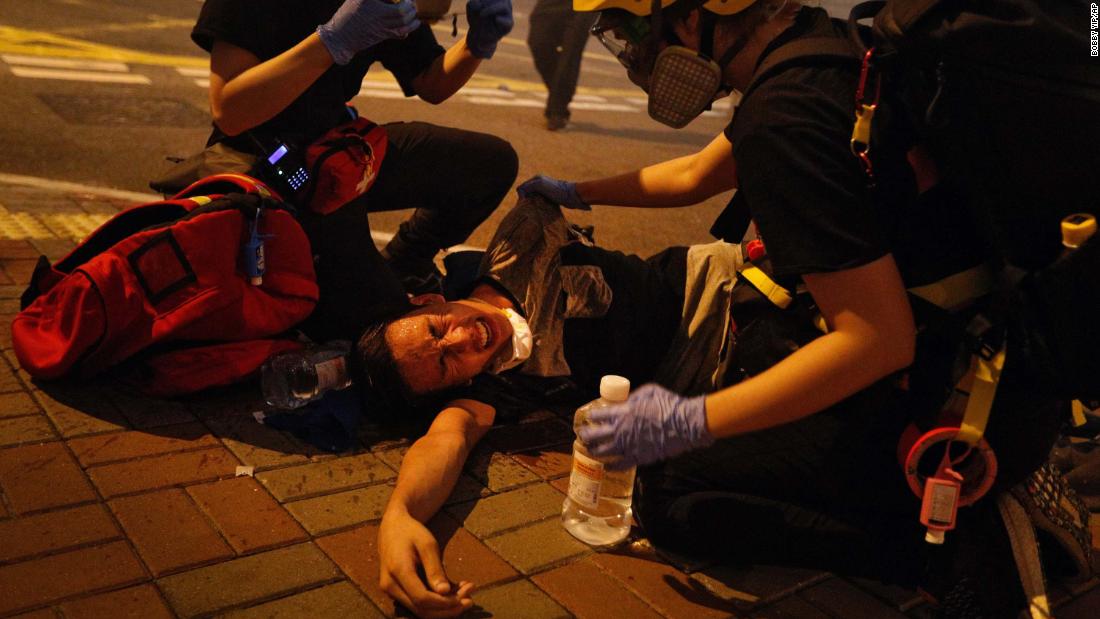
Medical workers help a protester affected by tear gas on July 21.
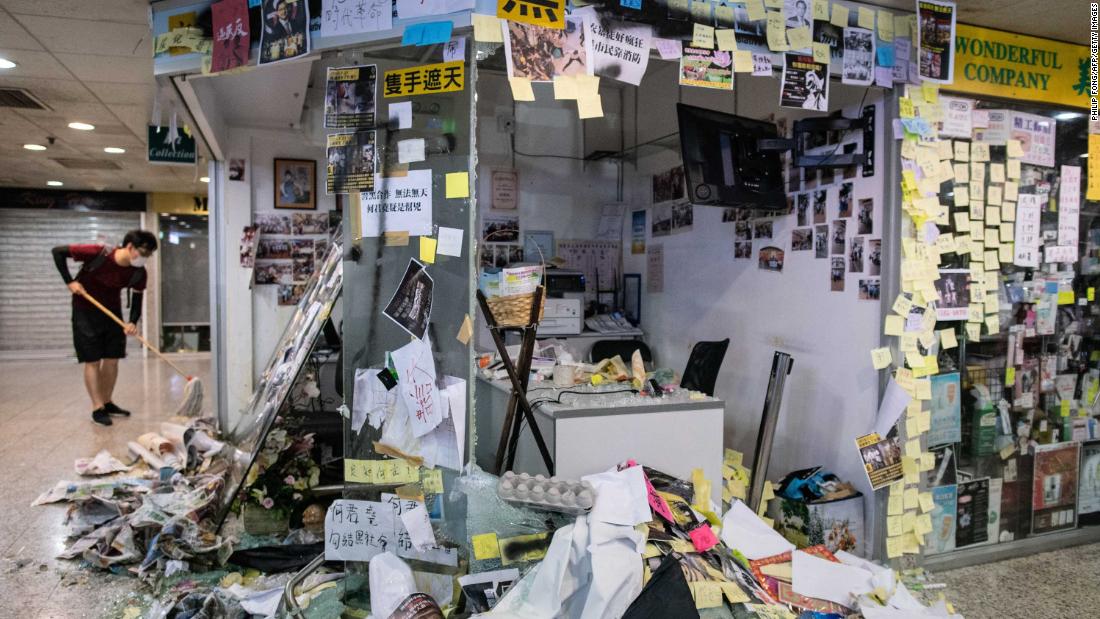
The office of pro-Beijing lawmaker Junius Ho was trashed by protesters in Hong Kong's Tsuen Wan district.

Police officers use pepper spray to disperse protesters after a rally in the Sheung Shui district on Saturday, July 13.
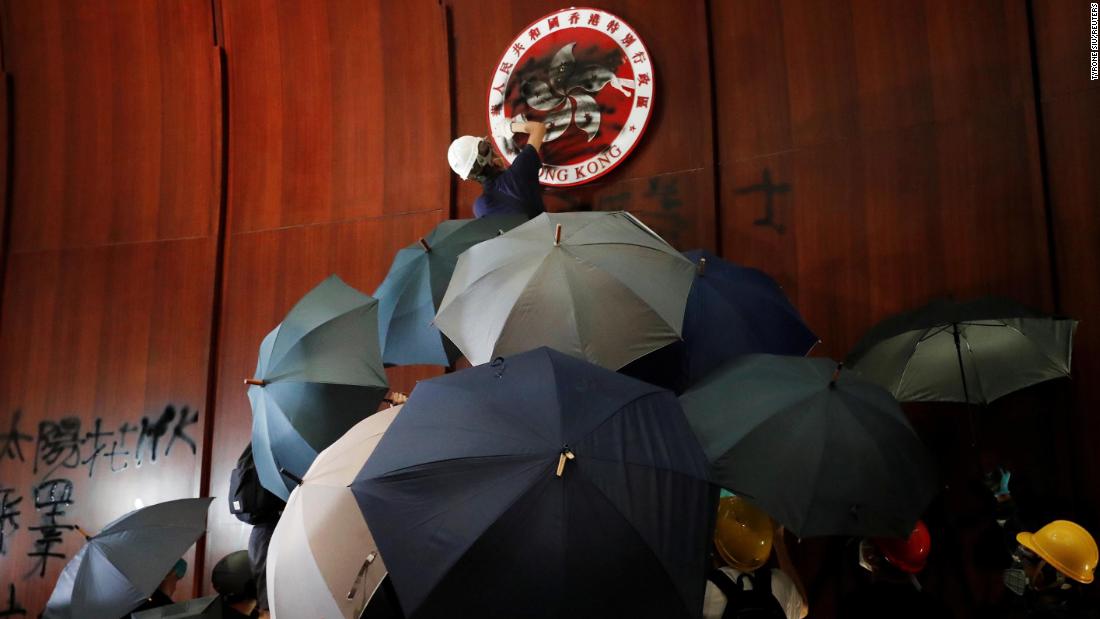
A demonstrator sprays paint inside a chamber at Hong Kong's Legislative Council building, where protesters forced their way in on Monday, July 1.

The meeting hall of the Legislative Council is taken over by demonstrators on July 1.

A protester smashes a window of the Legislative Council building.

Columns of sunlight are cast on a crowd during the march on July 1.

Helicopters carrying the flags of China and Hong Kong fly over demonstrators on July 1.

Pro-democracy lawmaker Roy Kwong rallies demonstrators with a megaphone on July 1.
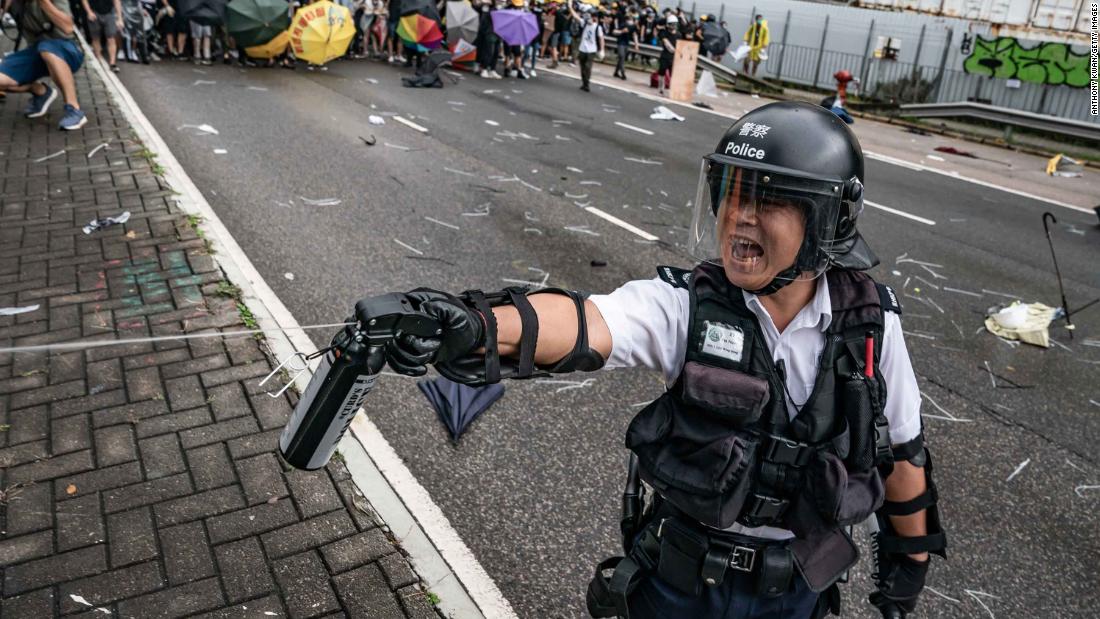
A police officer uses pepper spray during a clash with protesters on July 1.
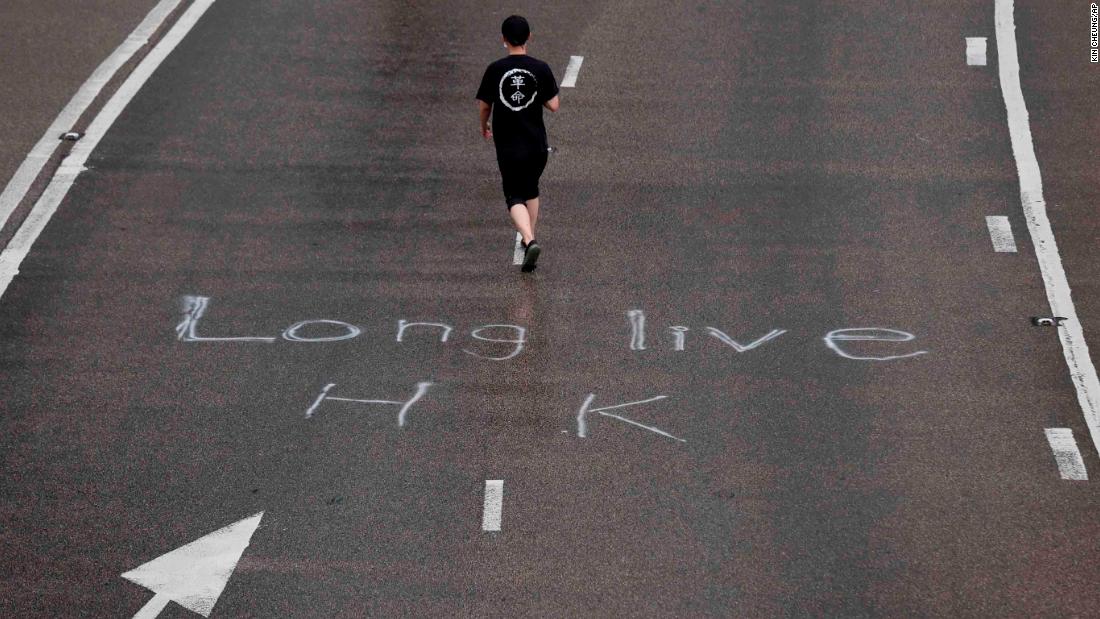
A protester wearing a T-shirt with the word "revolution" walks past an inscription on a road that reads "Long Live HK."

Police detain protesters near the government headquarters in Hong Kong on July 1.

An overhead view shows thousands of protesters marching through a Hong Kong street on Sunday, June 16.

Protesters run after police fired tear gas on Wednesday, June 12.

Protesters face off with police during the rally on June 12.
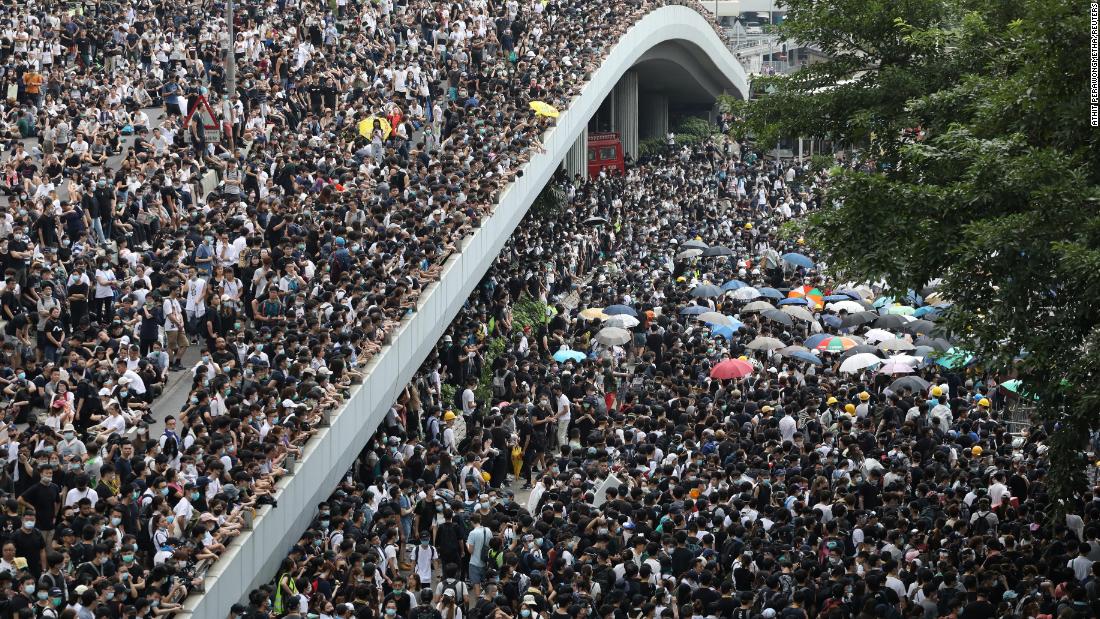
By the morning of June 12, tens of thousands of mainly young people had arrived in the area, blocking streets and bringing central Hong Kong to a standstill.

A demonstrator holds a sign during the June 12 rally.
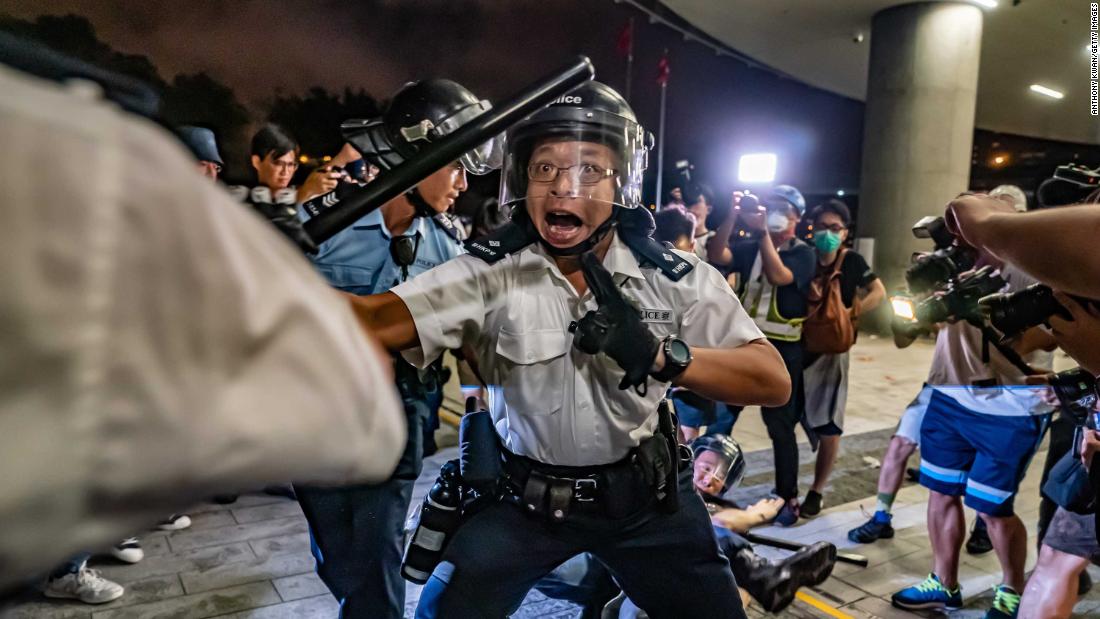
Police officers charge toward protesters during clashes on Monday, June 10. It was a continuation of protests that started the day before.

Protesters hold pictures of Hong Kong Chief Executive Carrie Lam on Sunday, June 9.
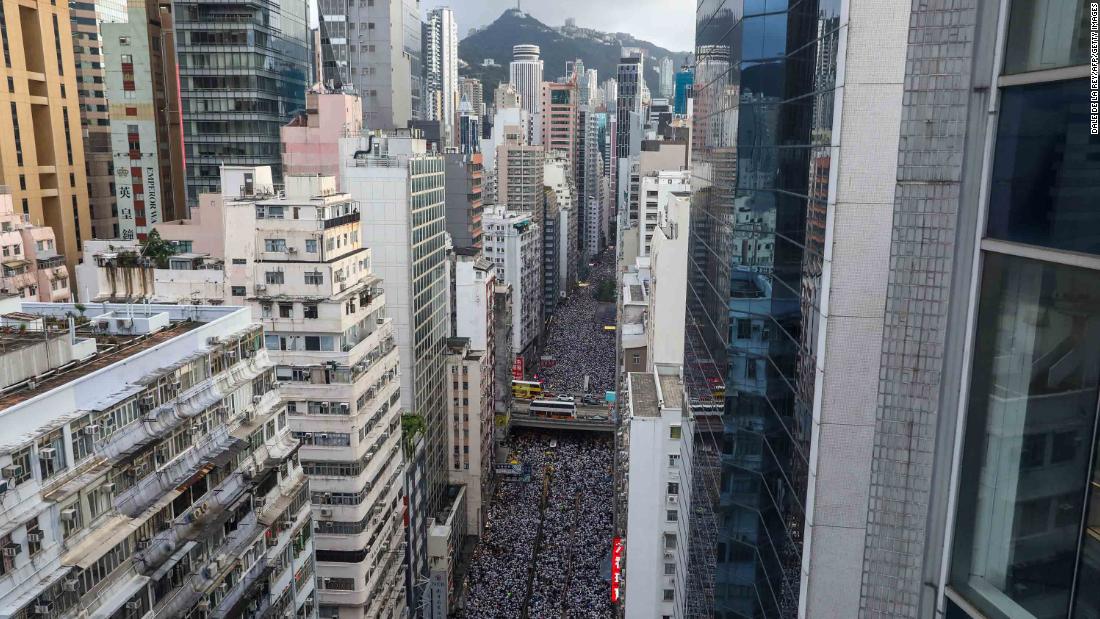
Protesters on June 9 waved placards and wore white -- the designated color of the rally. "Hong Kong, never give up!" some chanted.
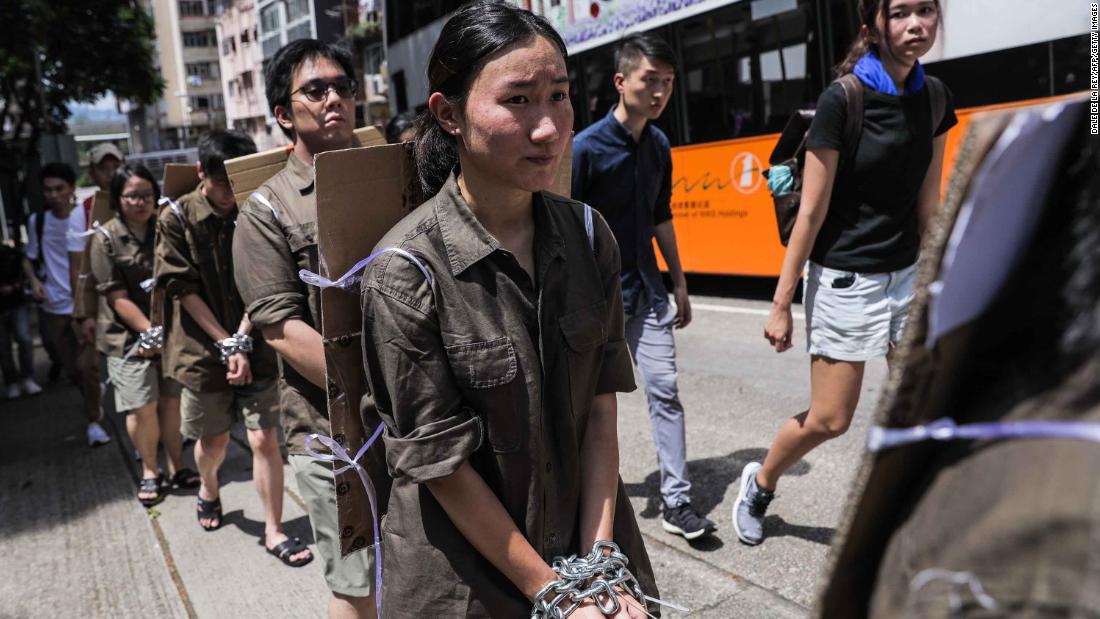
Students wear chains during a demonstration on Saturday, June 8.
Police under pressure
Speaking to reporters, senior police commanders emphasized the extreme pressure the force is under as the protests enter their sixteenth week.
"When we're off duty, we can't even have that sanctuary of normality," one commander said. "Officers can't even get married without protesters turning up to their wedding parties."
Police officials said a team of clinical psychologists was working with front line officers to provide support and allow police time to decompress from the stress and abuse. "We all recognize that this has an emotional toll, and our officers need to be supported," a senior commander said.
The commander added that "we are in a very desperate situation. We are the only agency that Hong Kong as a whole can rely on. For the desperate citizens, the law abiding citizens, we are the only part of the political structure in Hong Kong that they can rely on."
However, commanders rejected a suggestion that they were being asked to solve a problem that is beyond their capabilities and not receiving enough support from government. Previously, a senior police official told CNN that "this is a political issue, a political issue needs a political solution to solve it."
On Friday, senior officers suggested that the situation could be relieved by courts taking a larger role in enforcing the rule of law, such as fast tracking trials and granting less bail in cases of protester violence.

Post a Comment